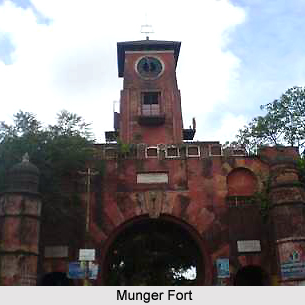Munger Fort is one of most historically significant fort located at Munger District in Bihar. Munger Fort is built on a rocky hillock on the south bank of the Ganges River.

Munger Fort has two prominent hills called the Karnachaura or Karanchaura, and the other a built up rectangular mound deduced to be the location of a citadel of the fort. Munger Fort had a succession of Muslim dynasties like Khalji Dynasty, Tughlaq Dynasty, Lodi Dynasty, Nawabs of Bengal, followed by Mughal rulers, till it was finally acceded to the British by Mir Quasim, after unseating his father-in-aw Mir Jafar on the grounds of old age, for a monetary reward negotiated by Vansittart.
Munger Fort houses a number of religious and historic monuments such as the Tomb of Pir Shah Nufa, Tomb of Mulla Muhammad Said, Palace of Shah Suja, and a British cemetery.
Under the rule of Muhammad bin Tughluq of Delhi, Munger fort was developed. Munger, which was under the rule of the Karnataka dynasty of Mithila, was taken over by Bhaktiyar Khalji in 1225 AD and subsequently under the Khalji ruler, Gyasuddin Khalji. Munger fort was the eyewitness of the Delhi Sultanate rule, Mughal Rule and the British rule. For a brief period, it came under the control of Sultan of Bengal between 1301 AD and 1322 AD, following a peace treaty with Khaljis.
From the time of the reign of Akbar in the late 16th century, the Mughal Emperors controlled Munger Fort. Raja Todar Mal, Minister in the Mughal empire had camped at this fort when he was deputed to put down the rebel forces of Bengal. He substantially refurbished the fortifications of the fort. After a series of intriguing changes in the governorship of Munger Shah Shuja, the second son of Shah Jahan, the Mughal Emperor and Aurangzeb`s brother, had fled to this place to escape persecution, during his fight with his brothers for power. After the decline of Mughal rule, the Britishers controlled Munger fort. During the time of British East India Company, Munger Fort, was taken by Lord Clive. This fort played a most important revolt in suppressing the Sepoy Mutiny 1857. The structure of the fort played a major role in restoring the control in the state. Now this place played a major role as a tourist spot in Munger District.



















